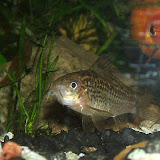 Six weeks ago I purchased a pair of albino Kribs (Pelvicachromis pulcher) - I've always wanted dwarf cichlids, and the new tank was in need of occupants that could handle "semi-aggressive" tankmates. (To be honest, while Macropodus are often described that way, mine have always been extremely gentle, inoffensive fish.)
Six weeks ago I purchased a pair of albino Kribs (Pelvicachromis pulcher) - I've always wanted dwarf cichlids, and the new tank was in need of occupants that could handle "semi-aggressive" tankmates. (To be honest, while Macropodus are often described that way, mine have always been extremely gentle, inoffensive fish.)Within a week the kribs started excavating a hole below a piece of driftwood. The female then started spending a lot of time beneath the driftwood. Cool, I thought, they are interested in mating. The second week passed, and the female spent a lot of time out of site. I didn't give it too much thought. Then at the start of week three I came home one day to notice both kribs were out on the open, keeping close to the bottom of the tank. As I looked a little closer I noticed movement beneath them and realised that they hadn't "considered" spawning, they had gone ahead and done so. Given that there were four large Macropodus in the tank with the kribs, I immediately became concerned for the safety of the fry. The kribs seemed to be attentive parents and the Macropdus had little interest in what went on at the bottom of the tank, but it still seemed only a matter of time until the krib fry turned into Macropodus snacks. It was thus quite a surprise when I realised that the kribs were quite effectively bullying fish that were 2-3 times their size. Even the (rather small) female krib was able to chase the Macropodus males off when they ventured too far down the water column.
Over the past three weeks the fry have grown remarkably quickly. Initially they foraged in a tight bunch on the bottom of the aquarium, attentively guarded by one parent (while the other parent patrolled the tank). As they got bigger they started moving away from the bottom, higher up the water column. On at least one occasion the parents seemed unsure what to do when half of the babies were on top of a piece of driftwood while the other half were foraging nearby on the bottom of the tank. Over the last week the fry have spread out and no longer forage as a group. They have also reached a size where they are no longer at much risk from the Macropodus - one of the fry ended up high enough in the water column that it attracted attention from one of the female Macropodus. She swam over to check it out, but then turned away. I'm guessing it was too big for her to consider it food.
Now what do I do with 20 kribs?
















